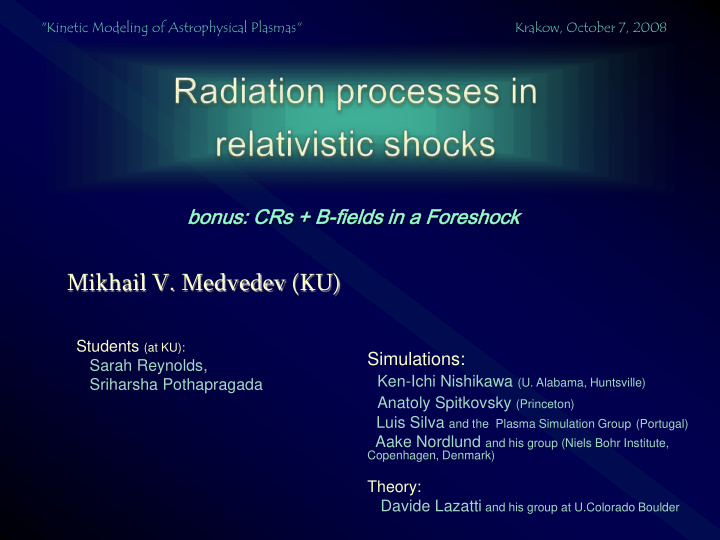



"Kinetic Modeling of Astrophysical Plasmas" Krakow, October 7, 2008 bonus: nus: CRs + B B-fiel elds ds in a Foreshoc eshock Mikhail V. Medvedev (KU) Students (at KU): Simulations: Sarah Reynolds, Ken-Ichi Nishikawa (U. Alabama, Huntsville) Sriharsha Pothapragada Anatoly Spitkovsky (Princeton) Luis Silva and the Plasma Simulation Group (Portugal) Aake Nordlund and his group (Niels Bohr Institute, Copenhagen, Denmark) Theory: Davide Lazatti and his group at U.Colorado Boulder
Motivation: ubiquitous Weibel – sub-Larmor-scale fields
Weibel shock: 2D PIC e - p , Γ =15 (Simulation by Spitkovsky)
Magnetized outflow: reconnection Small-scale field generation (Weibel instability) at a reconnection site …see talks at this conference Non-relativistic electron-positron pair plasma (Swisdak, Liu, J. Drake, ApJ, 2008) Relativistic electron-positron pair plasma (Zenitani & Hesse, PoP, 2008)
Jitter radiation
Radiation in random fields w s ~ g 2 w H w j ~ g 2 c/ l Deflection parameter: eB l d … independent of g 2 mc (Medvedev, 2000, ApJ)
Jitter regime When d << 1 , one can assume that particle is highly relativistic ɣ >>1 particle’s trajectory is piecewise-linear particle velocity is nearly constant r(t) = r 0 + c c t particle experiences random acceleration w ┴ (t) w ┴ (t) = random e - v = const (Medvedev, ApJ, 2000; 2006)
Jitter radiation. Theory Lienard-Wichert potentials Small-angle approximation The dominant contribution to the integral comes from small angles Spectral power (Landau & Lifshitz, 1963; Medvedev, ApJ, 2000)
Jitter radiation. Theory (cont.) Fourier image of the particle acceleration from the 3D “(vxB) where acceleration field” Lorentz force Ensemble-averaged acceleration spectrum B-field spectrum (Landau & Lifshitz, 1963; Medvedev, ApJ, 2000; Fleishman, ApJ, 2006, Medvedev, ApJ, 2006)
Radiation vs Θ B-field is anisotropic: B = ( B x , B y ) is random, B z =0 n z x v Θ observer (Medvedev, Silva, Kamionkowski 2006; Medvedev 2006)
Face-on view (credit: Hededal, Haugbolle, 2005)
Oblique view (credit: Hededal, Haugbolle, 2005)
Spectra vs. viewing angle n 0 Log F ν n 1 synch. n -h 2 > ~ k - η <B k n -h-1 Log ν (Medvedev 2006; S. Reynolds, S. Pothapragada, Medvedev, in prep.)
Jitter spectra from 3D PIC 1/3 (synch.) Bulk Lorentz factor = 15 PDF:Thermal +non-thermal (p=2.7) (Hededal, PhD thesis 2005)
Synchrotron “Line of Death” Statistics is large: About 30% of over 2700 GRBs violate synchrotron limit at low energies P( ω ) ~ ω +1 (Medvedev, 2000) (Kaneko, et al, ApJS, 2006)
Non-synchrotron GRB spectra Some GRBs cannot be synchrotron GRB 970111 soft photon index violates synchrotron limit for the entire burst (Beppo-SAX observatory: Frontera, et al., ApJ, 2000)
Multi-peak prompt GRB (Kaneko, et al. ApJS 2006; PhD thesis)
Multi-peak prompt GRB (Kaneko, et al. ApJS 2006; PhD thesis)
Multi-peak prompt GRB (Kaneko, et al. ApJS 2006; PhD thesis)
Multi-peak prompt GRB (Kaneko, et al. ApJS 2006; PhD thesis)
Multi-peak prompt GRB (Kaneko, et al. ApJS 2006; PhD thesis)
Multi-peak prompt GRB (Kaneko, et al. ApJS 2006; PhD thesis)
Jet viewing angle effect Jet opening angle Jet axis Θ jet To observer Θ obs Surfaces of equal times
“Tracking” GRBs Also, “hardness – intensity” correlation ; flux Also, “tracking behavior” α t 1 , bright, high E peak , aberration α ~0 t 2 , intermediate α ~ -2/3 Θ ~ Θ lab ~0 ~1/ γ t 3 , faint, low E peak , Θ ~ π /2, Θ lab ~1/ γ α ~ -1
Single pulse: F & alpha “lightcurves” Flux @ Epeak α No synch nch allow owed ed F ν ~ ν α
Prompt spectral variability a single pulse R/(2 Γ 2 c) α =1/3 F ν ~ ν α prompt Polarization may be expected, if jet is misaligned high-latitude (Medvedev, 2006) (Pothapragada, Reynolds, Medvedev, in prep)
Model lightcurves Thick shells Thin shells
Flux @ Epeak vs alpha -correlation
Are shock simulations relevant for GRBs?
Cooling & Weibel time-scales Inside the ejecta: from simulations Downstream an internal shock: Synchrotron cooling time Electron/proton dynamical time
Cooling & Weibel time-scales shock (Medvedev & Spitkovsky, in prep) prompt, large Γ -internal prompt
Cooling & Weibel time-scales shock (Medvedev & Spitkovsky, in prep) afterglow, strong explosion afterglow
Bonus: Self-similar foreshosk model with CR generated B-field
The model y B( γ (x)) downstream x x=0 n CR n CR x 2 >x 1 n CR x 3 >x 2 x 1 γ 1 γ 2 > γ 1 γ γ γ 3 > γ 2 γ B B B λ(γ) λ(γ) λ(γ) (Medvedev & Zakutnyaya, in prep)
Self-similar foreshock Assume steady state and neglect nonlinear effects: • effect of pre-conditioning of upstream on Weibel instability • nonlinear feedback of B-fields on • CR distribution function • Shock structure • CR acceleration • time evolution of generated fields Valid at Typical field: B-field spectrum near a shock (Medvedev & Zakutnyaya, in prep)
Conclusions Magnetic field with small spatial coherence length are ubiquitous. They form due to the Weibel-type instability via the current filament formation Radiation emitted by electrons in Weibel-generated magnetic fields – Jitter radiation – has spectral properties that make it more favorable over synchrotron models. The Weibel+Jitter shock model can be tested against GRB data: e.g., spectral variability and afterglow lightcurves A model of a self-similar foreshock magnetized by streaming CRs is presented, but more understanding is needed on B-field evolution and acceleration/heating larger and longer PIC simulations are needed More understanding is still needed for external shocks of afterglows (Weibel vs vorticity models, post-shock turbulence) and prompt emission (magnetized outflows)
Recommend
More recommend